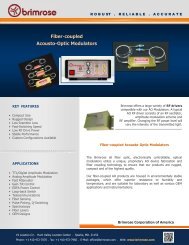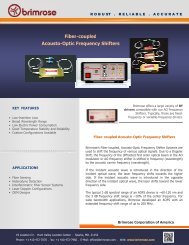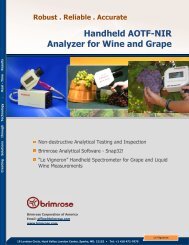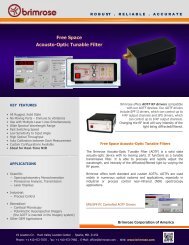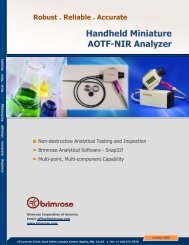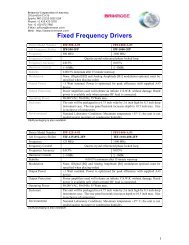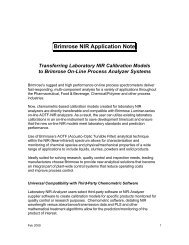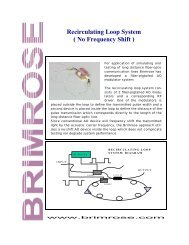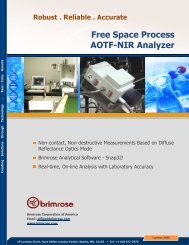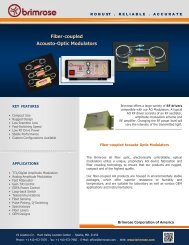Acousto-Optic Tunable Filters Spectrally Modulate Light - Brimrose ...
Acousto-Optic Tunable Filters Spectrally Modulate Light - Brimrose ...
Acousto-Optic Tunable Filters Spectrally Modulate Light - Brimrose ...
Create successful ePaper yourself
Turn your PDF publications into a flip-book with our unique Google optimized e-Paper software.
In a tellurium dioxide (TeO 2 ) noncollinear AOTF, the acoustic and optical waves propagate atquite different angles through the crystal. In this configuration, the zero-order and diffracted beamare physically separated, so that the filter can be operated without polarizers. Also, the twoorthoganally-polarized beams do not separate until they exit from the crystal, and the angle ofdiffracted beam is absent for the change in the first order with a change of wavelength. Thisimplies that only a single fixed detector is necessary during a spectral scan.Most AOTF devices are designed with two types of birefringent crystals depending uponoperational wavelength. TeO 2 is preferred AOTF material because of its high acousto-optic figureof merit. The crystal, although useful in the visible and infrared region up to 4.5 micrometers, isnot suitable for ultraviolet applications due to its short-wavelength transmission cutoff at 350 nm.For ultraviolet spectroscopy, crystalline quartz is used.Fast <strong>Tunable</strong> <strong>Light</strong> SourceThe AOTF can be incorporated with an incoherent light source or multiline white-light laser toproduce a fast tunable light source. It can be switched between any randomly selectedwavelength in microseconds, with resolution from several nanometers up to 0.1 nm. One of theapplications for this source is fluorescence spectroscopy. 4 Fluorescent probes can indicatediverse properties as ion concentration, pH, and electronic potential in live cells and tissues. Inacquiring kinetic date from fluorescent probes, it is often necessary to monitor the ratio of two (orseveral) excitation or emission wavelengths to cancel out the intensity of excitation and dyeconcentration, giving and accurate estimation of target ion concentration. It is also essential toalternate wavelengths as rapidly as possible. Conventionally, a spinning filter is used, but it isslow, hard to synchronize with opt electronic data collection, and also causes mechanicalvibration that can be troublesome in a microscopy setup.With an AOTF, these problems can be circumvented, because it is a solid-state device with nomoving parts. Also, a single AOTF can be used as a multiwavelength modulator. By coupling theAOTF to a broadband light source (or a multiline white laser) and driving the AOTF with two RFfrequencies, two excitation wavelengths can be generated simultaneously. Furthermore, eachwavelength can be modulated electronically at different frequencies, and lock-in amplifiers candemodulate the fluorescent emission into its two components.As an example, an AOTF can be coupled with an argon-krypton white laser that simultaneouslyemits 12 wavelengths. By simultaneously adding several RF frequencies with properly adjustedpower levels, artificial composite laser color can be generated that may find applications inconfocal microscopy, holograph, and laser entertainment.Scientists at the National Institutes of Health (Bethesda, MD) are pioneering innovativebiomedical and chemical applications of AOTFs. In one experiment, an argon laser equipped withan AOTF is used as a light source for fluorescent microscopy. 5 The narrow bandwidth, rapidwavelength selection (microseconds), and the intensity control enable a variety of measurementsto be made in an extremely short time. Recently, this system was used to bleach a small region ofa sample periodically at 514 nm to determine rates of flow and diffusion in two fibroblast cellsstained with a fluorescent dye (see first graphic at the top of the page). The sharp details andhigh signal-to-noise ratio result from the narrow bandwidth of the exciting light produced by thelaser-AOTF combination.
Figure 2. Near-IR light source illuminates water droplets at 960 nm (left) and 850 nm (right);wavelengths are selected by AOTF. Darkening of spots results from water absorption;reference bar corresponds to 7 micrometers.In another experiment, and AOTF coupled with a tungsten lamp provided a fast- tuning nearinfrared(NIR) light source for spectroscopic imaging of water (see Fig. 2). 6 The microscopeimages of water were collected at 960 nm and 850 nm; the darkening of the droplets at 960 nmcorresponds to the vibrational absorption of water (specifically, the second overtone O-H stretch).For presentation, the images are corrected for instrument response and backgroundcontributions.
Figure 3. AOTF telescopic polarized images of Saturn reveal methane absorption in rings at727 nm (top); interband space is evident by lack of absorption at 753 nm (bottom).Spectral ImagingBecause of its large field-of-view angle and high spatial resolution (>100 lines/mm), an AOTF canalso be used for spectral imaging applications. It can be used for acquiring spatial, spectral, andpolarization information from fluorescent probes in biological cells, space and terrestrialobservation, and image sensing. Spectral imaging at orthogonal polarizations can give thespectral properties and size distribution of gases and aerosols, in addition to revealing the natureof solid surfaces from their reflectance spectra. Figure 3 shows an orthogonally polarized imageof Saturn at 727 and 753 nm recorded by scientists at the NASA/Goddard Space Flight Center(Greenbelt, MD). The used a TeO 2 AOTF coupled into an imaging telescope system to producethese images. At the methane- absorption wavelength, the polarization contrast is enhanced.Near-Infrared SpectroscopyNear-infrared spectroscopy is a powerful diagnostic tool for identifying and analyzing theconcentrations of components in samples. For example, the starch, protein, liquid, and fiberconcentrations of grains, octane numbers of gasoline, moisture content of chemicals or food, orthe lignin content of pulp and paper can be determined through NIR analysis. However, forindustrial on-line monitoring, samples, which are usually moving, may be inhomogeneous andtheir compositions and optical characteristics may suddenly change.Measurements need to be performed rapidly to derive accurate compositional or qualityparameters. A large number of measurements may need to be averaged to correct errors. Also,data may need to be recorded at multiple wavelengths in real time, preferably simultaneously. For
this application, the spectrometer must be able to be tuned repeatedly to precise wavelengthsreliably over long periods of time. In addition, the spectrometer must be rugged, compact, flexible,and simple to operate. Problems in meeting these requirements with classical spectroscopictechnologies have limited the deployment of NIR spectroscopy in industrial and commercialapplications.Although instruments using other technologies have been successfully used, AOTF technology isunique in its ability to satisfy all the criteria for hands-off real-time NIR spectroscopy in theindustrial environment. With the advent of rugged, compact, fast spectrometers based on AOTFtechnology, NIR spectroscopy is set to fulfill its promise as an important on-line diagnostic tool. 7Figure 4. For industrial on-line analysis, an AOTF selects wavelengths for NIRspectrometer; sampling is via a fiber bundle.In an AOTF spectrometer, the output of a tungsten lamp is collimated and directed into a TeO 2AOTF (see Fig. 4). The monochromatic output beam from the AOTF is coupled into a bifurcatedfiber bundle. The fiber exits the spectrometer and terminates in a probe designed for reflection orfinite-path-length absorption measurements. <strong>Light</strong> from the sample passes back along the fiberwhere it is focused onto a photo detector. The normalized signal intensity at each wavelength isdigitized by a high-speed 16-bit analog-to-digital converter before being stored and/or analyzedby the central processing unit.





